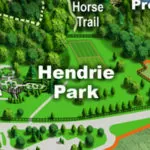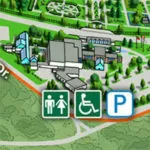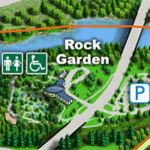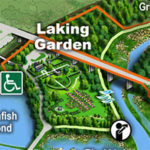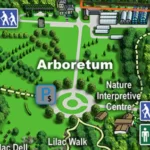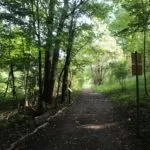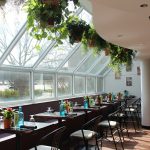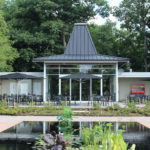| Membership | Price (+HST) |
|---|---|
| Single | $85/year |
| Single Plus | $120/year |
| Family | $130/year |
| Family Plus | $175/year |
| Contributing | $300/year |
| Supporting | $600/year |
| Sustaining | $1,000/year |
| Benefactor's Circle | $2,500/year |
| Director's Circle | $5,000/year |
| President's Circle | $10,000/year |
Arboretum
RBG’s Arboretum is more like an English landscape park than a garden. As its name implies, this is the place where you can see a wide variety of trees and other woody plants up close. It is especially beautiful in spring and fall.
Key Attractions
- Flowering Tree Collections (May and June)
- Trailhead leading to Cootes Paradise
- Nature Interpretive Centre
- Anishinaabe waadiziwin Trail
Quick Facts
- Over 47 hectares (116 acres)
- Showcases 1,096 types and 2,416 individual plants
- Home to one of the largest lilac collections in the world (over 400 varieties)
Visiting the Arboretum
Parking
- Paid parking is in effect, $5/hr to a maximum of $15.
- Pay by credit or debit upon exit, or pay by credit, debit, or cash at the pay station at the parking circle (near the pavilion).
- Parking is included in RBG Membership. Parking card is required for entry.
Check back for 2025 peak bloom visiting information.
Getting to the Arboretum
16 Old Guelph Road, Hamilton, L9H 5Y5
Arboretum Hours
Today’s Hours
Seasonal Hours
- 8 a.m. to dusk (May 28 to Apr 30)
Exceptions
- Dec 25 Christmas Day: Closed
- Dec 26 Boxing Day: Closed
- Dec 31 New Years Eve: 10 a.m. to 3 p.m., last admission 2 p.m.
- Jan 1 New Year's Day: Closed
Collections & Areas of Interest

- Katie Osborne Lilac Collection
- Magnolia Collections East and West
- Dogwood and Redbud
- Crabapple Collection
- Flowering Cherries
- Avenues of Trees
- Toni Carson Shrub Collection
- The Pinetum
Katie Osborne Lilac Collection
Peak Interest: Mid to Late May
The Lilac Dell exhibits over 400 species and cultivars of common lilacs. French hybrids form the basis of the collection, but also displayed are Preston hybrids (originated in Canada by Isabella Preston), early-bloomers such as hyacinth lilacs and a selection of species found in the wild. An introductory Lilac Walk at the entrance to the Lilac Dell is organized in a series of exhibits that interpret the desirable breeding characteristics of lilacs, and major developments in the history of lilac breeding. On more challenging terrain, The Katie Osborne Lilac Collection within the Lilac Dell is one of the most diverse and one of the definitive collections to demonstrate the range of the genus Syringa. A popular seasonal attraction, it provides visitors with weeks of delightful springtime colour and fragrance.
Magnolia Collections
Peak interest: April and May
Magnolias are among the most primitive of flowering plants, with fossil remains dating back over 100 million years. Relatively unchanged since then, they are found in the wild in tropical and temperate Asia and America. The collection, located in two separate areas of the Arboretum, displays a selection of magnolias that are hardy in our area. The collection also exhibits Ontario’s native magnolia, the Cucumber-Tree (Magnolia acuminata), an endangered species found wild in only a few locations in the Carolinian Zone. The western section of the collection was originally developed as a memorial to local architect Lester Husband, while the eastern section, near the Synoptic Shrub Collection, commemorates past Gardens’ staff member R. A. Sims.
Dogwood and Redbud Collection
Peak interest: May
RBG’s woodlands are home to some species more commonly found in the southern United States. For example, south of the lilac dell the collection of dogwoods (mostly Cornus florida and its cultivars) and redbuds (Cercis canadensis) at the edge of this woodland provide a springtime show of mauve-pink and white blossoms. A member of the Pea family, Redbud reaches the natural limits of its range near Lake Erie, though it can be planted further north. Interestingly, Cornus are commonly used as shrubs in the landscape but can reach 5m tall in their natural habitat.
Crabapple Collection
Peak interest: May (flowers) and fall (fruit)
Our display highlights the range of form and colour in the Malus genus. Crabapples are a common small tree used in residential landscapes. Over the years RBG has grown and evaluated many of the hundreds of cultivars bred from the two-dozen or so wild species found in North America, Europe and Asia.
Flowering Cherries
Peak interest: Late-April or Early-May
At RBG, our flowering cherries are part of our early spring celebrations. Globally, flowering cherry trees have a long history, especially in Japan where cherry blossoms are celebrated, and flowering times recorded dating back 1300 years. RBG also annually records the flowering times of its Cherries as part of a biological science known as phenology which is an important tool in helping to track climate change. In 2010, we added 34 trees to this collection, donated to RBG as part of the Sakura Project. These trees are planted at both the Arboretum and Rock Garden sites and are a must see in early spring.
Toni Carson Shrub Collection
Peak interest: all year
The Toni Carson Shrub Collection presents a living encyclopedia of shrubs that can be grown in our area. Like a dictionary, it is organized alphabetically, by genus, from A to Z. It includes species as well as cultivated plants commonly available in the horticultural trade as well as unusual shrubs that are harder to find and have been sourced from other botanical gardens through plant exchanges.
The Pinetum
Peak interest: all year
Also called evergreens, needle-leaved trees or softwoods, conifers are trees whose seeds are open to the air, most often in cones. Most keep their leaves for at least two years, and all have soft resinous wood.
Ontario’s tree emblem reflects the major role that some members of this group of plants have had on our history—the British Navy’s demand for Eatern White Pine (Pinus strobus) shaped the early settlement of our province. Along with pines, spruce, and firs the Pinetum explores the diversity of conifer genera around the world and features 140 unique types represented by over 200 individuals.
The Journey to Anishinaabe Knowledge
Peak interest: all year
Native plants provided Indigenous peoples with almost all of life’s essentials. Starting in the Arboretum near the Nature Interpretive Centre, this new trail explores plants used by the Anishinaabe peoples, and their connections to culture, language, ecology and history.
What’s in Bloom & Plants of Interest at the Arboretum
March
- Witch-Hazel
- Avenues of Trees
April
- Witch-Hazel
- Redbud
- Flowering Cherry*
- Magnolia*
- Avenues of Trees
May
- Redbud
- Flowering Cherry*
- Crabapple (flowers)
- Lilac (late-May)
- Dogwood
- Avenues of Trees
Bloom times can vary from year to year as they are influenced by many natural events including temperature and climate. Please bear in mind that if we experience an early or late spring, bloom times could shift up to 10 days earlier or 10 days later.
*These plants have short bloom times and are very weather dependant. Check our social media feeds closer to bloom time for updates.
June
- Lilac (early-June)
- Dogwood
- Avenues of Trees
- Synoptic Shrub Collection
July
- Avenues of Trees
- Synoptic Shrub Collection
August
- Avenues of Trees
- Synoptic Shrub Collection
Bloom times can vary from year to year as they are influenced by many natural events including temperature and climate. As Please bear in mind that if we experience an early or late spring, bloom times could shift up to 10 days earlier or 10 days later.
*These plants have short bloom times and are very weather dependant. Check our social media feeds closer to bloom time for updates.
September
- Seed Bearing Trees
- Crabapple (fruit)
- Synoptic Shrub Collection
October
- Fall Colours
- Pinetum
- Synoptic Shrub Collection
November
- Witch-Hazel
- Pinetum
- Synoptic Shrub Collection
Bloom times can vary from year to year as they are influenced by many natural events including temperature and climate. As Please bear in mind that if we experience an early or late spring, bloom times could shift up to 10 days earlier or 10 days later.
Winter
- Witch-Hazel
- Pinetum
- Fruit-bearing shrubs
- Grasses
Upcoming Activities & Tours at the Arboretum
Some events may require pre-registration, and may not be covered by your garden admission. For a full listing of events across all RBG’s gardens, visit the Events Calendar.
Arboretum FAQ
Directions / Parking
The Arboretum is located at 16 Old Guelph Road, Hamilton ON.
Metered parking is in effect beyond staffed hours, $5/hr to a maximum of $15. Parking is FREE to RBG members with a RBG parking pass.
Learn more about getting to RBG at rbg.ca/directions
Parking is available in 3 lots: Parking Circle (central) and Entry Gate (east, ~400m to lilacs), and Rasberry House (north, ~400m to lilacs). See the map above to familiarize yourself with the locations, and the distance to various collections. Accessible parking spaces are available in the Parking Circle.
How Far is the Arboretum from RBG’s Other Garden Areas?
- Arboretum to Rock Garden: 1.7 km / 1 mile
- Arboretum to Laking Garden: 2.4 km / 1.5 miles
- Arboretum Hendrie Park/RBG Centre: 3.7 km / 2.3 miles
Walking to and from the Arboretum is NOT recommended; Old Guelph Road does not include sidewalks. Please consider driving or biking between locations, or using the shuttle service when available (weekends, spring to mid-summer).
Are there Washroom Facilities Available?
Portable washrooms are available at the Arboretum.
Are water bottle filling stations available?
Water Fountains / bottle filling stations are available at all RBG garden areas.
At the Arboretum, outdoor bottle refill available at the Nature Interpretive Centre.
Food and Drink / Picnics
Pack a picnic! Outside food is permitted at the Arboretum (excluding special events). Please pack-out or properly dispose of any waste. Outdoor cooking is not permitted in any of RBG’s garden areas.
Outside food is not permitted at RBG Centre, Hendrie Park, or Rock Garden. Outside food is only permitted at Laking Garden and the Arboretum (excluding special events).
Is the Arboretum Accessible?
The lilac walk at the arboretum is paved / packed gravel, though most of the Arboretum is grassy field, or rough trail pathways. Descending into the lower lilac dell includes a steep slope, not recommended for those with mobility issues.
Accessible parking spaces are available in the Parking Circle.
Trail User Code
Upon entering the nature trails you are making a pledge to respect the environment and fellow visitors. These lands are Canada’s biodiversity hotspot, set aside at the head of Lake Ontario for environmental protection, open for environmental education and passive recreation only. While walking our trails, it is important to remember that you are a visitor in someone else’s home, and that your impact will be multiplied over by 200,000 other visitors. Environmental protection bylaws are posted at each trailhead. Please follow them and play a role in protecting and restoring the area for future generations.
Trail Use Bylaw Restrictions
The properties and activities are regulated by the Royal Botanical Gardens Act and supporting bylaws.
- Trail running is not permitted.
- Pets must remain leashed at all times. Please clean up after your dogs and leave waste trailhead garbage receptacle.
- Bicycles are prohibited on the trails.
- Motorized vehicles are prohibited.
- Horseback riding is prohibited.
- Picking or collecting plants or wildlife is prohibited.
- Feeding the wildlife/birds is not permitted.
- Cross-country skiing is prohibited due to the hilly topography.
- Ice skating is restricted to Cootes Paradise in the area adjacent to Princess Point.
- Use of drones is prohibited under RBG bylaw and further regulated by NavCanada.
Can I Bring My Dog?
Leashed dogs are permitted in the gardens for a visit during regular operating hours. Please be responsible and clean up after your dog. Dogs must remain on-leash and on-trail at all times.
Some special events at this location may not accommodate dogs. These are noted in the individual event FAQ’s available on the event pages.

